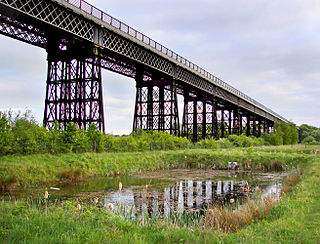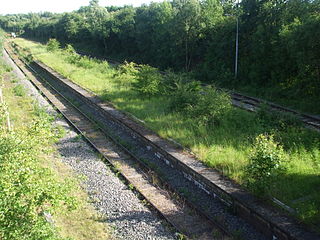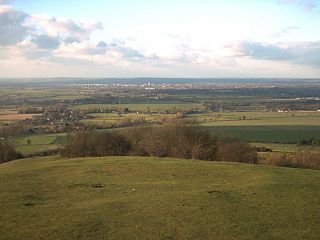
The Tay Bridge carries the railway across the Firth of Tay in Scotland between Dundee and the suburb of Wormit in Fife. Its span is 2.75 miles. It is the second bridge to occupy the site.

The Millau Viaduct is a multispan cable-stayed bridge completed in 2004 across the gorge valley of the Tarn near Millau in the Aveyron department in the Occitanie Region, in Southern France. The design team was led by engineer Michel Virlogeux and English architect Norman Foster. As of October 2023, it is the tallest bridge in the world, having a structural height of 336.4 metres (1,104 ft).

The Landore viaduct is a railway viaduct over the Swansea valley and the River Tawe at Landore in south Wales. It provides a link between Swansea city center and the West Wales Line to the South Wales Main Line. The valley crossing provides a panoramic view of Landore, Kilvey Hill, the Liberty Stadium and the Swansea Enterprise Park.

The Medway Viaducts are three bridges or viaducts that cross the River Medway between Cuxton and Borstal in north Kent, England. The two road bridges carry the M2 motorway carriageways. The other viaduct carries the High Speed 1 railway line linking London and the Channel Tunnel. All three bridges pass over the Medway Valley Line.

Bennerley Viaduct is a former railway bridge, now a foot and cycle bridge, between Ilkeston, Derbyshire, and Awsworth, Nottinghamshire, in central England. It was completed in 1877 and carried the Great Northern Railway's (GNR) Derbyshire Extension over the River Erewash, which forms the county boundary, and its wide, flat valley. The engineer was Samuel Abbott, who worked under Richard Johnson, the GNR's chief engineer. The site required a bespoke design as the ground would not support a traditional masonry viaduct due to extensive coal mining. The viaduct consists of 16 spans of wrought iron, lattice truss girders, carried on 15 wrought iron piers which are not fixed to the ground but are supported by brick and ashlar bases. The viaduct is 60 feet high, 26 feet wide between the parapets, and over a quarter of a mile long. It was once part of a chain of bridges and embankments carrying the railway for around two miles across the valley but most of its supporting structures were demolished when the line closed in 1968. The only similar surviving bridge in the United Kingdom is Meldon Viaduct in Devon.

The Ouse Valley Viaduct carries the London-Brighton Railway Line over the River Ouse in Sussex. It is located to the north of Haywards Heath and the south of Balcombe. Known for its ornate design, the structure has been described as "probably the most elegant viaduct in Britain."
Eiffage S.A. is a French civil engineering construction company. As of 2010 it was the third largest company of its type in France, and the fifth largest in Europe.

Calvert was a railway station at Calvert, Buckinghamshire on the former Great Central Main Line between Manchester Piccadilly and London Marylebone. The station was opened in 1899 and closed to passengers in 1963 and goods in 1964.

High Speed 2 (HS2) is a planned high-speed railway line and network of passenger train services in Great Britain. The new railway line, which is currently under construction in England, is to run between the West Midlands and London, with a spur to Birmingham. A network of train services will use the new line and existing conventional track to reach their destinations in the Midlands, North West England, and Scotland. HS2 is to be Britain's second purpose-built high-speed line after High Speed 1, which connects London to the Channel Tunnel. The majority of the project is planned to be completed between 2029 and 2033.

Birmingham Curzon Street railway station is the planned northern terminus of High Speed 2 on the fringe of Birmingham city centre, England. The new railway will connect Birmingham to London Euston via Birmingham Interchange and Old Oak Common. Curzon Street will have seven terminal platforms and is planned to open in 2026.

The Colne Valley Regional Park is 43 square miles (110 km2) of parks, green spaces and reservoirs alongside the often multi-channel River Colne and parallel Grand Union Canal, mainly in Hertfordshire and Buckinghamshire, with parts in the London Borough of Hillingdon, Berkshire and a small area in Surrey.

The Aylesbury Vale is a geographical region in Buckinghamshire, England, which is bounded by the City of Milton Keynes and West Northamptonshire to the north, Central Bedfordshire and the Borough of Dacorum (Hertfordshire) to the east, the Chiltern Hills to the south and South Oxfordshire to the west. It is named after Aylesbury, the county town of Buckinghamshire. Winslow and Buckingham are among the larger towns in the vale.

The history of High Speed 2 is the background to the planned construction of High Speed 2 (HS2), a new high-speed railway in Great Britain that would connect London, Birmingham, Manchester, Leeds and other cities in the UK.

The Colne Valley Viaduct is a bridge, under construction as of 2023, which will carry the High Speed 2 railway over the Colne Valley Regional Park and the Grand Union Canal, in Hillingdon, west London. When completed, its length of 3.4 kilometres (2.1 mi) and a weight of 116,000 tonnes will make it the largest railway bridge in the UK. It is one of the largest single civil engineering works of HS2 Phase 1.
The Chiltern Tunnel is a high-speed railway tunnel currently under construction in Buckinghamshire and Hertfordshire, England, and will upon completion carry the High Speed 2 (HS2) railway line under the Chiltern Hills. The twin-bore tunnels, which are 16.04 km long, will be the longest on the HS2 line. Each tunnel will also have additional 220 m (720 ft) entry and 135 m (443 ft) exit perforated concrete portals to reduce sudden changes in air pressure and subsequent noise.

The Northolt Tunnel is a high-speed railway tunnel currently under construction in Greater London, England, and will upon completion carry the High Speed 2 (HS2) railway line under the West London suburbs. The twin-bore tunnels will run for 8.4 miles (13.5 km) between Old Oak Common and Ruislip. As of January 2024, the first tunnel boring machine has completed 35% of its bore length.
The Wendover Dean Viaduct is a planned railway viaduct that will carry the High Speed 2 (HS2) railway line across farmland between Wendover and Great Missenden, Buckinghamshire, England.
The HS2 automated people mover is a planned automated people mover (APM) in Solihull, England being built in conjunction with the High Speed 2 project in order to improve connections between HS2's upcoming Interchange station, Birmingham Airport, and other rail and community infrastructure.

The Chirk Viaduct is a Grade II* listed railway viaduct over the River Ceiriog between England and Wales. The viaduct carries the Shrewsbury–Chester line from the Welsh town of Chirk in historic Denbighshire from the north to the English village of Chirk Bank in Weston Rhyn, Shropshire to the south. Chirk Aqueduct lies parallel to the viaduct's east.
Balsall Common Viaduct is a railway viaduct under construction in Balsall Common that will carry the High Speed 2 railway line.















